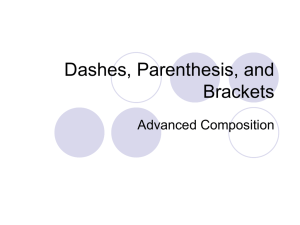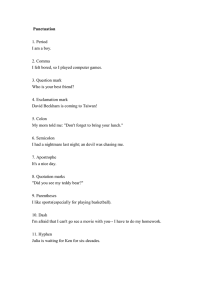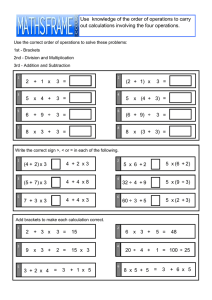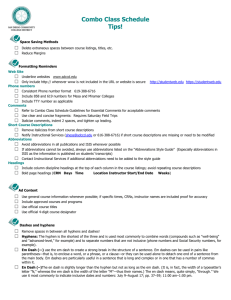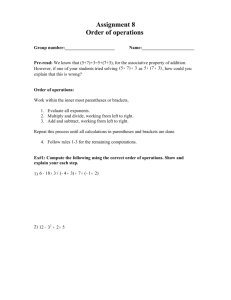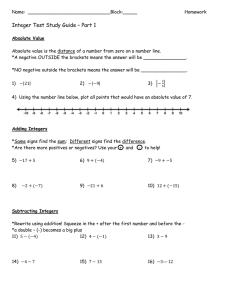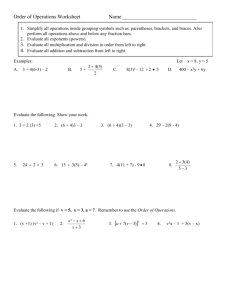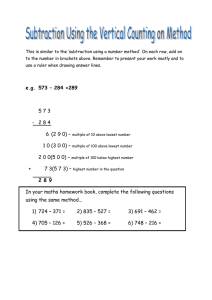Writing for the RCOG - Royal College of Obstetricians and
advertisement
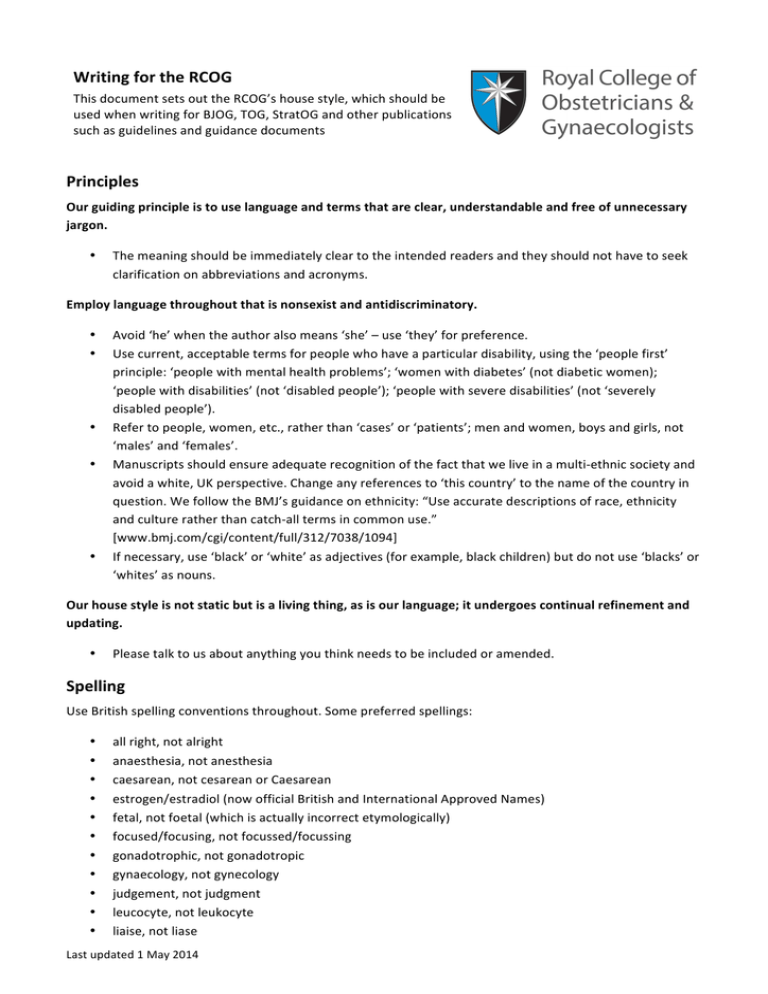
Writing for the RCOG This document sets out the RCOG’s house style, which should be used when writing for BJOG, TOG, StratOG and other publications such as guidelines and guidance documents Principles Our guiding principle is to use language and terms that are clear, understandable and free of unnecessary jargon. • The meaning should be immediately clear to the intended readers and they should not have to seek clarification on abbreviations and acronyms. Employ language throughout that is nonsexist and antidiscriminatory. • • • • • Avoid ‘he’ when the author also means ‘she’ – use ‘they’ for preference. Use current, acceptable terms for people who have a particular disability, using the ‘people first’ principle: ‘people with mental health problems’; ‘women with diabetes’ (not diabetic women); ‘people with disabilities’ (not ‘disabled people’); ‘people with severe disabilities’ (not ‘severely disabled people’). Refer to people, women, etc., rather than ‘cases’ or ‘patients’; men and women, boys and girls, not ‘males’ and ‘females’. Manuscripts should ensure adequate recognition of the fact that we live in a multi-­‐ethnic society and avoid a white, UK perspective. Change any references to ‘this country’ to the name of the country in question. We follow the BMJ’s guidance on ethnicity: “Use accurate descriptions of race, ethnicity and culture rather than catch-­‐all terms in common use.” [www.bmj.com/cgi/content/full/312/7038/1094] If necessary, use ‘black’ or ‘white’ as adjectives (for example, black children) but do not use ‘blacks’ or ‘whites’ as nouns. Our house style is not static but is a living thing, as is our language; it undergoes continual refinement and updating. • Please talk to us about anything you think needs to be included or amended. Spelling Use British spelling conventions throughout. Some preferred spellings: • • • • • • • • • • • all right, not alright anaesthesia, not anesthesia caesarean, not cesarean or Caesarean estrogen/estradiol (now official British and International Approved Names) fetal, not foetal (which is actually incorrect etymologically) focused/focusing, not focussed/focussing gonadotrophic, not gonadotropic gynaecology, not gynecology judgement, not judgment leucocyte, not leukocyte liaise, not liase Last updated 1 May 2014 • • • • regimen, not regime (for drug or treatment) specialty, not speciality (in medical contexts) subspecialty, not sub-­‐specialty Use -­‐ise, not-­‐ize: organise, organisation, realise, advise, advertise, sympathise, legalise, etc. However, the World Health Organization keeps the z, as this is its proper name. Words often misspelled: accommodate, correspondence, liaison, receive, separate, millennium Names All names should be spelled correctly and not ‘translated’ into English; e.g. American College of Obstetrics and Gynecology, not American College of Gynaecology. Drugs Use UK generic names where possible, e.g. oxytocin. Follow the preferred spelling of drug names given in BNF (British National Formulary). Where there is a different International Approved Name, list this in brackets on first use; e.g. adrenaline (epinephrine) and then use the British Approved Name (BAN). Names can be checked in a recent edition of BNF or on the website http://bnf.org/bnf/index.htm. Many BANs are now being ‘internationalised’, so check before you use and follow BNF usage. Always prefer a generic drug name. If a proprietary name must be used, for the first use follow with ®, and then the manufacturer’s name and location in brackets, e.g. Syntocinon® (Alliance, Chippenham, Wilts). After the first use of a proprietary name, it is acceptable simply to give the name with no manufacturer’s details. You need only include ®. Generic drug names should be spelled entirely in lower case; an initial capital is only necessary for proprietary names. Always check the spelling of drug names. Diseases Disease names do not need an initial capital letter, unless the name is derived from a name or other proper noun. Some disease names created in this way have passed into common usage without an initial capital. Most medical dictionaries give US spellings. Mosby’s Medical, Nursing and Allied Health Dictionary (6th edition, ISBN 0-­‐723-­‐43225-­‐2) gives British spellings and has useful appendices. Foreign words and Latin Do not use italics for Latin words in common medical usage (et al., in vitro, in vivo, in utero, in situ, etc.) Use italics for other foreign words, except when they have passed into English usage; for example: regime (no accent or italic). It is always preferable to use an English word or phrase instead of the Latin, if possible (e.g. ‘in place’ rather than ‘in situ’). Genes and proteins Gene names are set in italics. Human genes take an initial capital; animal genes are all in lower case. Note: the proteins that code for genes are written in roman, not italic. Last updated 1 May 2014 Capital letters Avoid capital letters in the text wherever possible. There is no reason to use capitals for generic bodies, such as Social Services, Health, the Team, Consultant, Doctor, NHS Trust, or even Obstetrics and Gynaecology. This applies in headings as well as the body of the text: most headings should have an initial capital only (as in this document). Named organisations or authorities take capitals but general references do not; for example: ‘Devon Health Authority was...’; ‘one health authority was...’; ‘Yorkshire Health Services decided...’; ‘the health services decided...’. Often, you will find that a hospital etc. is named, and is afterwards referred to as the Hospital. In this case, the capital is retained, as it is shorthand for the named hospital. The same rule applies for job titles: avoid capitals when talking about the job in a generic sense, but apply initial capitals when a person’s specific job title appears in the text (e.g. in bylines). The Government takes a capital letter when it refers to central Government. As a simple adjective, however, it does not; for example, ‘recent government legislation’. Some further examples: • • Lower case: care manager, care management, community care, environmental health services (general sense), purchaser, provider, regional health authority, district health authority, health trust. Upper case: Named Regional Health Authority, Named Hospital, the National Health Service (and the Health Service), the NHS Management Executive, the New Right, Second World War, in the West, Stage I, II etc. (FIGO cancer stages), X-­‐ray Abbreviations and acronyms These should be used sparingly. As a rule, never allow an unexplained abbreviation in a run of text. If the abbreviation is only used a few times, spell out in full throughout. Avoid using abbreviations for two-­‐word phrases. Always spell the words out in full first. Include the abbreviation in brackets after the first instance of use. There are a very few universally acknowledged abbreviations that do not need to be spelled out in full first: • • • • • • • AIDS (acquired immune deficiency syndrome) CI (confidence interval) OR (odds ratio) DNA (deoxyribonucleic acid) SD (standard deviation) UK (United Kingdom) USA (US as adjective) United States of America. Capitals do not take full points: UK, USA, CHC, FHSA, NHS, GP, DHA, etc. Articles with capital abbreviations agree with pronunciation: an MBE, a UN document. Plurals of capital abbreviations take a lower-­‐case s and need no apostrophe: MPs, HAs. Contractions: no full points after contractions, rather than abbreviations, e.g. Dr, Mrs, Mr, St Versus: prefer in full, not vs. (unless to save space in a table) and roman not italic type. Last updated 1 May 2014 & (ampersand): should not be used in text except where part of a proper name; e.g. The Obstetrician & Gynaecologist journal. The RCOG style notes detail commonly used abbreviations and acronyms, drug trial names etc.. These are available on request. Punctuation Full point (stop) Use a single space after a full point. Many typists have been trained to use two spaces after the end of a sentence. This was fine in the days of typewriters. However, when using MS Word, the program automatically spaces the sentence once you have used a full point. If you use two spaces, this unbalances the program’s spacing and causes problems when the text is flowed into our typesetting program. Measurements and weights No full points are needed after measurements and weights: 3 lb 6oz, 250 g, 7 kg, 6 cm (NB: use metric weights for preference). Page references and times These always take a full point: p. 35–41; 7 p.m. Etc. Do not allocate etc. an extra full point at the end of a sentence. et al. Always takes full point. Do not italicise. NB. When used in reference list, precede with a comma. No. When short for ‘number’, this always takes a full point to avoid confusion with the word ‘no’. Comma A comma is rarely necessary before ‘and’ or ‘or’ in a list. Before linking two parts of a sentence with ‘and’ consider whether two sentences would be easier to read and make your meaning clearer. Quotation marks Use single quotes throughout. The only exception is when you need to use double within single, or when quoting direct speech. Display quotes: indent both left and right. Do not include quote marks. Book and journal titles do not take quote marks but are italicised. Titles of articles from journals and chapters from books do not take quote marks or italicisation. Acts of Parliament do not take quote marks and are not italicised. Where something has been left out of quoted matter, use an ellipsis to indicate this: ‘The hospital response was immediate ... and to the point.’ Last updated 1 May 2014 Apostrophes Apostrophes are used only to indicate possession or the omission of letters or numbers; e.g. don’t, ’99. They are not used to form plurals, with the one exception of letters of the alphabet, e.g. p’s and q’s. General rule for indicating possession with nouns: • • Singular nouns: use an apostrophe and an s, e.g. company’s, business’s. Plural nouns (ending in s): use just an apostrophe, e.g. companies’, businesses’. When indicating possession with singular proper names that end in s, generally include another s after the apostrophe if that is how it would be pronounced, e.g. James’s, Jones’s, etc. Two exceptions are Greek names, e.g. Achilles’ heel, Archimedes’ principle; also cases where the institution has made a conscious house style decision, e.g. St Thomas’ Hospital. Gestation Please use the full form: 37 weeks of gestation. 37 weeks’ gestation takes an apostrophe (but always avoid this form of use). Brackets Round brackets ( ) should generally be used. Within these, use square brackets [ ] but avoid this usage if at all possible. You may find that a dash – works instead or (for preference) reconstruct the sentence for clarity. Online (StratOG.net): follow the same rules as above, except for references. When a reference is hyperlinked to the abstract of that paper and not the full text article, use square brackets to indicate this and hyperlink the entire reference, including ‘[Abstract]’. Bartley DL, Morgan L, Rimsza ME. Gardeneralla vaginalis in prepubertal girls. Am J Dis Child 1987;141:1014– 17 [Abstract]. (If the whole sentence is within brackets, the full point comes within the brackets, like this.) If only part of the sentence is in brackets, the full point comes outside the brackets (like this). Hyphenation Hyphens are utilitarian, therefore usage may alter according to context and whatever seems best for clarity. There is a difference between ‘the deep-­‐blue sea’ and ‘the deep blue sea’; and between ‘four year-­‐ old children’ and ‘four-­‐year-­‐old children’. Avoid over-­‐ use of hyphens. RCOG house style is generally to close up words where this makes sense, rather than hyphenating. Single words: breastfeeding, childbirth, fundholder/fundholding, ongoing (but avoid this ugly word; rather use continuing), overspend, infrared, stakeholder, feedback (noun), healthcare (adjective), inpatient, outpatient, overexpression, viewpoint, subtotal, lifestyle, downregulation, upregulation. Prefixes: generally closed up, as follows: • • • • • ante…, e.g. antenatal, antepartum co…, e.g. cooperate, coordinate intra…, e.g. intrauterine, intrapartum multi…, e.g. multidisciplinary, multinational post…, e.g. postnatal, postpartum (but post-­‐term, to avoid two t’s together) Last updated 1 May 2014 • • • pre…, e.g. preterm, prelabour, preovulatory peri…, e.g. perinatal, perimenopausal extra…, e.g. extrauterine There are some exceptions where two vowels or consonants come together, e.g. multi-­‐organ, inter-­‐ relationship, etc. However, this is not a general rule and in a number of such cases the closed-­‐up form has become standard, e.g. contraindication, intraepithelial, intrauterine, cooperate, coordinate. Sometimes, a hyphen is necessary to ensure clarity or to make a word easier to read, e.g. pre-­‐existing. No hyphen is needed in compound adjectives where the first part is an adverb: highly commended guidelines, differently shaped curve. Nouns do not need hyphenation: decision making, problem solving, health care, the local authority (although they may need a hyphen to avoid ambiguity when used in an adjectival phrase, e.g. the decision-­‐ making process). Always hyphenate self-­‐ …, e.g. self-­‐consciousness, self-­‐completion. En dash An en dash (en rule) is longer than a hyphen. Use an en dash to give a range; e.g. 12–15 years old (in Microsoft Word, hold down Control and press the minus key on the numeric keypad). Use an en dash to indicate a minus number; e.g. –23. Where two words are linked to indicate some form of inter-­‐relationship, use an en-­‐dash rather than a hyphen; e.g. Beckwith–Weidemann syndrome, Denys–Drash syndrome, Breslow–Day test, cost–benefit analysis, blood–brain barrier, dose–response. This is often found where surnames of two people (discoverers/inventors) are used as the name of something. En dashes can be used if you need to avoid using brackets (see above). Avoid using an en dash in a sentence where a colon will work just as well. Do not use an en dash where the word ‘and’ should be used, such as to follow ‘between’; e.g. the drug should be administered between 12 and 24 hours apart. Lists Use bulleted rather than numbered lists, unless there is a specific reason for needing numbers. Introduce a list with a colon. Two styles are used: • • Short lists: no initial capitals; no punctuation at the end of each point. Each point must agree grammatically with the beginning of thesentence. A full point follows the last point in the list. Long lists: each point is a complete sentence; begin each point with an initial capital and end with a full point. Online (StratOG.net): follow the same rules as above for initial capitalisation, but do not include any punctuation at the end of each point for both short and long lists. Last updated 1 May 2014 Numbers, units and symbols Numbers Spell out numbers one to ten, except in dates, measurements and money (see below) and in a list combining large and small numbers, e.g. 2, 6, 12, 43. Above the number ten, use figures. Five-­‐digit or longer numbers take a space between thousands, NOT a comma, e.g. 123 095 not 123 095. However, large sums of money always take commas: £100,000.00. Two-­‐fold, three-­‐fold, ten-­‐fold, 16-­‐fold, etc. – use hyphens and spell out as words as above. Try not to use a number at the beginning of a sentence. If you do need to start a sentence with a number, spell it out in words; e.g. Two hundred and fifty women were entered in the trial. Ordinals: use as for plain numbers; e.g. first, not 1st, 13th not thirteenth. Dates and time Dates take the form: 1 April 1996. Abbreviations for years are in the form 1984/85: for example, the 1996/97 financial year. For a range of years, use an en-­‐dash: 1984–86. Always avoid phrases such as ‘two years ago’ and ‘recently’; change these to the exact date or period, unless you know that your document has a very limited shelf life. The word ‘recently’ is almost always unnecessary. Measurements of time are units so, in text, they should not be spelled out as words, e.g. 5 years, 3 hours. Do not use abbreviated forms of time units; e.g. s (seconds), h (hours) except in tables and figures to save space. Units Use metric units where possible. Dosage of drugs: prefer / [slash] rather than per; e.g. 3 mg/day, not 3 mg per day. Note: NEVER use mcg or μ (Greek mu) for micrograms; always spell out in full to avoid confusion. Pulse rate: use beats/minute (bpm). Mathematical symbols Avoid using mathematical symbols in a run of text. Write words in full. Less than/more than: prefer write in full, do not use < or > in text. In tables, where space is a premium, symbols are acceptable. Minus sign: use an en-­‐dash closed up to number: –34 (in Microsoft Word, hold down Control and press the minus key on the numeric keypad). Ranges: use an en-­‐dash (not a hyphen) to separate numbers, e.g. 10–15. Fractions: These are spelled out in words and hyphenated: three-­‐quarters, two-­‐thirds. Fractions associated with a number should always agree with the number, e.g. two and a half, 15.5, 24.75. Percentages: if spelling out the number, use the word ‘percent’; if using figures, use the % symbol, closed up to the number. Last updated 1 May 2014 Probability: use capital P (italicised). Confidence intervals Separate the elements in a confidence interval with an en dash, unless there is a negative number involved, when the word ‘to’ should replace the en dash to avoid confusion; e.g. 95% CI 1.2–3.6 but 95% CI –1.2 to 1.0. Some grammar A collective noun is usually singular: a range of alternatives was proposed; the department wants to speak to the team; the team wants to speak to the editor. However: a number of options were proposed. Depending on the context, you may decide to treat a group noun as either singular or plural, but do so consistently. NOT, for example: The team discusses alternatives then they choose the best. Past participles: use -­‐ed for verbs (we learned; they burned) and -­‐t for adjectives (undreamt-­‐of achievements). Hopefully is an adverb that means ‘with hope’ or ‘full of hope’; it does not mean ‘it is hoped that...’ or ‘we hope that...’. Some common grammatical errors are shown in Appendix 1. References Always use the numbered (Vancouver) system of referencing. Check through the text to make sure that all citations are included in the reference list and vice versa. You should include all references in full at the end of the document, using the uniform requirements for manuscripts submitted to biomedical journals [reference: International Committee of Medical Journal Editors. Uniform requirements for manuscripts submitted to biomedical journals. Med Educ 1999;33:66–78.] List the names and initials of all authors (unless there are more than six, when only the first six should be given followed by ‘, et al.’. Do not use ‘and’ before the final author. Online (StratOG.net): do not use superscript for references. Instead follow the same rules as above but cite the reference using round brackets, the first author’s surname, et al. if more than one author, followed by the year of publication and closed bracket, e.g. ‘Men exposed to pesticides were found to have higher serum estradiol concentrations (Oliva et al. 2001).’ Hyperlink the reference citation to the article, whether abstract or full text, and also list the reference below the article in the reference box. Where to cite within the text When a name or study is cited, the reference citation should be attached to the name or study, not at the end of the sentence, e.g. ‘When Magos et al.5 introduced transcervical resection of the endometrium...’ not ‘When Magos et al. introduced transcervical resection of the endometrium...5’. The superscript number should appear after any punctuation, e.g. ‘the study by Jones et al.3 found that...’ Formatting of references Full examples of the most common types of references are detailed below. Please pay careful attention to the required punctuation and capitalisation, as these typically take up a large amount of time during the editing stage if they are incorrect. An invaluable website for checking journal article references is PubMed, which is located at Last updated 1 May 2014 http://www.ncbi.nlm.nih.gov/PubMed/; this site allows virtually instant searching of medical journals using authors’ names or words from the article title. It is quick and easy to copy and paste citations into your document, with only minimal additional formatting being required. Note that we do not generally use issue numbers in references. Examples of journal article references 1. Brown ZA, Benedetti J, Ashley R, Burchett S, Selke S, Berry S, et al. Neonatal herpes simplex virus infection in relation to asymptomatic maternal infection at the time of labour. N Engl J Med 1991;324:1247– 52. 2. MacLean AB. Urinary tract infection in pregnancy. Br J Urol 1997;80 Suppl 1:10–13. [Note formatting of supplements.] 3. Anonymous. Cytomegalovirus in adults. Lancet 1977;ii:541. 4. American Academy of Pediatrics Committee on Infectious Diseases and Committee on Fetus and Newborn: Guidelines for prevention of group B streptococcal (GBS) infection by chemoprophylaxis. Pediatrics 1992;90:775–8. 5. Smaill F. Intrapartum antibiotics for group B streptococcal colonisation. Cochrane Database Syst Rev 2000;(2):CD000115. [Note: often incorrectly cited as monographs with publisher statement.] Examples of book and report references 6. Peckham C, Marshall WC. Infection in Pregnancy. In: Obstetrical Epidemiology. London: Academic Press; 1983. p. 209–59. 7. Johnstone RW. Textbook on Midwifery. 8th ed. London: Black; 1936. 8. Swapp GH. Asymptomatic bacteriuria, birth weight and length of gestation in a defined population. In: Brumfitt W, Asscher AW, editors. Urinary Tract Infection. London: Oxford University Press; 1973. p. 92– 102. 9. Drife J, Lewis G, editors. Why Mothers Die. Report on Confidential Enquiries into Maternal Deaths in the United Kingdom 1994–96. London: The Stationery Office; 1998. 10. World Bank. Improving Women’s Health in India. Washington DC: World Bank; 1996. 11. Department for International Development. Time for Action: Reducing the Dangers of Pregnancy in Poor Societies. London: Department for International Development, Health and Population Division; 1997. 12. UNAIDS. Report on the Global HIV/AIDS Epidemic – June 2000. Geneva; 2000. 13. Royal College of Obstetricians and Gynaecologists. Prenatal Screening for Toxoplasmosis in the UK. Report of a Multidisciplinary Working Group. London: RCOG; 1992. 14. American College of Obstetricians and Gynecologists. Perinatal Herpes Simplex-­‐Virus Infections. ACOG Technical Bulletin 122. Washington DC: ACOG; 1988 Last updated 1 May 2014 Examples of conference proceedings/abstracts references (not published) 15. Renjifo B, Essex M, Mwakagile D, Hunter D, Msamanga G, Spiegelman D, et al. Differences in vertical transmission between HIV phenotypes. Second Conference on Global Strategies for the Prevention of HIV Transmission from Mothers to Infants, 1–5 September 1999, Montreal, Canada. Abstract 099. 16. Lallemant M, Jourdain G, Le Coeur S, Kim S, Karnchanamayul V, Hansudewechakul R, et al. Perinatal HIV prevention trial (PHPT), Thailand: simplified and shortened zidovudine prophylaxis regimen as efficacious as PACTG076. XIII International AIDS Conference, 9–14 July 2000, Durban, South Africa. Abstract LbOr032000. Personal communication references These references should be numbered and cited in the text as for any other type of reference. The simple format is as follows: 17. R Gilbert, personal communication. Journal articles in press ‘In press’ references are only permissible if the article has been formally accepted by the journal for publication. Information from manuscripts not yet accepted for publication should be cited as personal communications or unpublished data (with the permission of the author). The year of publication must be given (and this should in most cases be the current year). 18. Baxter N, Sumiya M, Cheng S, Erlich H, Regan L, Simons A, et al. Recurrent miscarriage and variant alleles of mannose binding lectin and tumour necrosis factor genes. Clin Exp Immunol 2001. In press. Website reference citations Where a reference is solely to a website, give the url within square brackets. Where the citation is to a publication that is printed and also available on a website, give the normal citation first followed by the url in square brackets. Examples of website citations 19. UK National Screening Committee [www.doh.gov.uk/nsc/index.htm]. 20. Online Mendelian Inheritance in Man [www.ncbi.nlm.nih.gov/Omim/]. Examples of online publications (that also have print citations) 21. Alan Guttmacher Institute. Sharing Responsibility: Women, Society and Abortion Worldwide. New York: Alan Guttmacher Institute; 1999 [www.agi-­‐ usa.org/pubs/sharing.pdf]. 22. World Health Organization. Maternal Mortality in 1995: Estimates developed by WHO, UNICEF, UNFPA. Geneva: WHO; 2001 [www.who.int/reproductive-­‐ health/publications/RHR_01_9_maternal_mortality_estimates/index.en.html]. 23. Huntingdon D. Meeting Women’s Health Care Needs After Abortion. Program Briefs 1. Washington DC: Population Council/FRONTIERS; 2000 [www.popcouncil.org/pdfs/frontiers/pbriefs/Progr am_Briefs_1001900.pdf]. Last updated 1 May 2014 Copyright Please enclose a copy of your permission to reproduce with your submission. Obtaining permission to reproduce such items is usually the responsibility of the author. Illustrative matter All artwork (figures, tables, photographs, etc.) that has appeared in published form requires permission for reproduction from the copyright holder. Images and photographs are subject to copyright, just as is text. Someone owns them unless they have been explicitly placed in the public domain. Images on the Internet are NOT free simply because you can download them. All images must be licensed directly from the copyright holder or someone able to license on their behalf. In the case of a photograph, the copyright owner is often the photographer. Most books will have an ‘acknowledgements’ page and this is where you will often find the information you need about who owns the images used. Text All textual extracts from published material, no matter how short, require written permission and this must be obtained and submitted with the manuscript. However, please avoid lengthy quotes if at all possible. Further reading Butcher J. Copy-­‐editing: The Cambridge Handbook for Editors, Authors and Publishers. 4th ed. Cambridge: Cambridge University Press; 2006. Walker JR, Taylor T. The Columbia Guide to Online Style. 2nd ed. New York: Columbia University Press; 2006. Baron D, Clarke HC. Units, Symbols and Abbreviations: A Guide for Authors and Editors in Medicine and Related Sciences. 6th ed. London: RSM Press; 2008. Tables Tables should be numbered sequentially through the document. Tables should have a title above, ranged left, with no full point at the end. A table must have more than one column. A bulleted list is not a table. Figures The use of figures is encouraged. All figures must be cited in the text. Please supply a separate list of captions/legends. All figures should be clearly labelled for identification purposes and the top indicated to avoid any errors in printing. Most formats of image files can be handled, in either PC or Mac versions. Adobe Photoshop or Illustrator files are best. Please send the highest quality version available. Please note that the resolution of any image taken directly from the Internet is too low for printing (72 dpi) purposes and we are unable to use such images in print. A minimum of 300 dpi is necessary for printing. • JPEG: use low compression only. Highly compressed files are only suitable for use on the web, as too much information is lost in compression and the image will be blurred when printed. Last updated 1 May 2014 • • • TIFF: preferred format. EPS: preferred format. GIF: unsuitable. Do not use/send. Microsoft PowerPoint slides may be sent as a guide for the figure to be redrawn. We may be unable to extract usable images from this program. Please do not embed images into the text of a Word document, as this renders them unusable; always supply separate native files. Hard copy originals (photographs, slides etc.) DO NOT WRITE directly on the back of photographs or use paper clips or staples. Writing may show through when printed. Use labels stuck on the back of the photograph. If you wish to use only part of an illustration, please mark on an overlay the area to be reproduced. Do not mark the print. Half-­‐tones should be sharp, well contrasted, unmounted glossy prints, where possible. Last updated 1 May 2014 Appendix 1. Common grammatical errors Alternative and alternate An ‘alternative’ is a choice (strictly you should have only two alternatives but most authorities are now more relaxed about this). ‘Alternate’ is used to mean ‘by turns’ – ‘day alternates with night’. Among and between Use ‘between’ when you are writing about two items and ‘among’ for more than two. For example, it is correct to write: ‘the differences between drug A and drug B were minimal’; ‘there were no obvious differences among the three drugs tested’. Both Use ‘both’ only if you are discussing two things. So, don’t write: ‘Audit groups often report that they underestimated the resources required for the task, both in terms of finance, project management and general administrative support.’ In this example, it would be correct to use ‘both’ if the groups hadn’t underestimated the financial resources required, in which case you could write: ‘Audit groups often report that they underestimated the resources required for the task, both in terms of project management and general administrative support.’ Can and may ‘Can’ should be used for things that are possible. ‘May’ is used for what is permissible. So, to say ‘sildenafil cannot be used in women’ is incorrect as women are physically capable of swallowing a sildenafil tablet. Care with ‘ing’ endings Take care when using verb forms ending with ‘ing’ (the present participle) – check that your sentence could not be misinterpreted. Incorrect: ‘Researchers investigated the reaction in rats using the XYZ apparatus.’ (The rats are using the apparatus?) Correct: ‘Researchers using the XYZ apparatus investigated the reaction in rats.’ or ‘Using the XYZ apparatus, researchers investigated the reaction in rats.’ Compare with or compare to? Use ‘compare with’ if you are comparing the similarities or differences between items. For example, ‘Compared with his last marathon, the London to Brighton bike ride was a piece of cake.’ Use ‘compare to’ if you are likening two things; for example, ‘she compared the taste to that of saccharin’ would mean that she thought it tasted like saccharin. Usually you will need ‘compare with’. Dependant or dependent? ‘Dependant’ is a noun (for example, a child is a dependant); something that depends upon something else is ‘dependent’ upon it. Dose and dosage ‘Dose’ refers to the single amount of drug, whereas ‘dosage’ also includes details of the timing; e.g. ‘He took a 300-­‐mg dose of aspirin and then felt much better.’ ‘The dosage was aspirin 300 mg four times daily.’ Last updated 1 May 2014 Due to ‘Due’ is an adjective (e.g. ‘Reply by the due date’). ‘Due to’ is also adjectival and so should modify a noun. Correct: ‘The train is due to arrive at 14.10.’ (‘due to arrive at 14.10’ is an adjectival phrase that describes the train). Correct: ‘The train was late. The delay was due to leaves on the line.’ (‘due to leaves on the line’ is an adjectival phrase that describes the delay). Incorrect: ‘Due to leaves on the line, the train was late.’ Incorrect: ‘The train was late due to leaves on the line.’ In the last two examples, ‘due to leaves on the line’ does not describe the train. Here it would be correct to use ‘because of’ or ‘owing to’. When ‘due to’ is used after ‘was’, you can sometimes tell if it is being used wrongly if you test whether you could substitute ‘attributable to’ for ‘due to’. If you cannot, do not use ‘due to’. On the whole, try to avoid writing ‘due to’. If you mean ‘because of’, say so. Incorrect: ‘The Committee was unable to make a recommendation due to the lack of evidence.’ Correct: ‘The Committee was unable to make a recommendation because of the lack of evidence.’ Or: ‘Owing to the lack of evidence, the Committee was unable to make a decision.’ Effect/affect The verb ‘to affect’ means to influence something or to adopt a certain manner or pose. The verb ‘to effect’ means to accomplish something. As a noun, you would usually want ‘effect’ (‘affect’ has a narrow meaning relating to emotional states). The following phrases are correct. The researchers investigated the effects of dietary interventions alone in patients who had had a myocardial infarction. They investigated how dietary interventions affected the rate of myocardial infarction. To effect a change in life style is not easy. Former and latter Refer to the ‘former’ or the ‘latter’ only when you are referring to one of two (not more) previously mentioned items. Incorrect: The patients’ reported adverse effects included headache, lethargy and nausea, the latter being the most commonly cited.’ Correct: ‘The two most common adverse effects were headache and nausea. The former was reported by more than 60% of patients.’ Included Use ‘included’ to introduce a list only if you are not listing everything. For example, ‘The criteria included age above 40 years and a positive history of smoking’ is correct if there were other criteria that you have not mentioned here. Last updated 1 May 2014 If you are writing the full list, use ‘were’ or ‘are’. For example, write ‘The criteria were age above 40 years and a positive history of smoking’ if these were the only criteria. Inquiry and enquiry An inquiry is a formal investigation into something, whereas to make an ‘enquiry’ is to ‘ask in a general context’. Although many people use these words interchangeably, for the sake of consistency, please use them according to these definitions. Led and lead ‘Led’ is the past tense of the verb ‘to lead’ (‘Dr Peters led the team …’). The ‘lead’ spelling that sounds like ‘led’ is the metal (‘the house had old lead piping’). Less and fewer Use ‘less than’ if what you’re referring to is a continuum, and ‘fewer than’ if you’re referring to something discrete. You won’t be far wrong if you use ‘fewer than’ with numbers or things and ‘less than’ with quantities. Licence and license The ‘licence’ is the noun (‘the licence was issued in 1997’). ‘To license’ is a verb (‘the drug was licensed in 1997’). May and might Use ‘may’ if there is or was more than one possible outcome. Use ‘might’ when discussing something that could have happened but didn’t because a condition for its happening was not fulfilled – ‘he might have looked better if he’d had his hair cut’. In some cases using ‘may’ instead of ‘might’ can change the meaning: ‘Changing the drug regimen may have saved the patient’ (The patient is alive, perhaps as a result of the change in drug regimen.) ‘Changing the drug regimen might have saved the patient’ (The patient is dead, but it’s possible she would have survived if the drug regimen had been changed.) ‘May’ and ‘might’ can also be used to indicate degrees of tentativeness; for example, ‘I may be wrong’, ‘I might be wrong’, ‘there might be a strike tomorrow’, ‘there may be circumstances in which that would be allowed’. Methodology and methods Methodology is a system of methods used in a particular area of study (for example, the Cochrane Review Methodology Database) or the science of methods. So the words ‘method’ and ‘methodology’ are not interchangeable – don’t write ‘The methodology used in this study …’. Nor and neither If you use ‘neither’ in a sentence, you should use ‘nor’ rather than ‘or’. So you would write ‘Neither the twice-­‐ daily nor the three-­‐times-­‐daily regimen was acceptable to patients.’ You can use ‘nor’ without ‘neither’ – the Concise Oxford Dictionary lists ‘nor’ as meaning ‘and not, and not either’, so you could write ‘The drug should not be administered by unqualified staff, nor should it be administered in settings other than the specialist clinic.’ Last updated 1 May 2014 Only ‘Only’ is a word that modifies another word or phrase. Generally, it should be placed near to the word or phrase that it is modifying. The three examples below show how the sense of a sentence can be changed by moving the ‘only’ around. Dr Peters only works in the Park Road practice on Mondays and Tuesdays. (This implies that on the other days Dr Peters does something else in the Park Road practice – probably not what the author meant.) Dr Peters works in the Park Road practice only on Mondays and Tuesdays. (Dr Peters doesn’t work anywhere else on Mondays or Tuesdays.) Dr Peters works in the Park Road practice on Mondays and Tuesdays only. (Dr Peters doesn’t work in the Park Road practice on Wednesday to Sunday.) Practise and practice ‘Practice’ is the noun – for example, you would talk about ‘a doctor’s practice’, while ‘to practise’ is the UK English verb form (so you’d talk about ‘a doctor who practised medicine …’). Note that Americans use ‘to practice’ as the verb form. This, these and those Avoid using ‘this’, ‘these’ or ‘those’ when it is not clear what is being referred to – it is better to repeat a word or paraphrase. Also, don’t assume that people will read headings: repeat the word or phrase when necessary. Some possibly confusing examples follow. Potentially confusing: ‘Brown attempted to measure patient QALYs using carers as proxies but these may not accurately reflect those of the patient or society.’ Better version of the above sentence: ‘Brown attempted to measure patient QALYs using carers as proxies but such measurements may not accurately reflect the impact of the disease on the patient or society.’ Best of all: ‘Brown attempted to measure patient QALYs using carers as proxies. Such measurements, however, may not accurately reflect the impact of the disease on the patient or society.’ (Two shorter sentences better than one long one.) Potentially confusing: ‘Reports from other centres [Heading] Most of these are now several years old and relate to a time when only two of the four drugs being considered were available.’ Better version of the above sentence: ‘Reports from other centres [Heading] Most reports from other centres are now several years old and relate to a time when only two of the four drugs being considered were available.’ Varying, various, variety of ‘Varying’ should be used in the same way as ‘changing’. Correct: ‘During the monitoring period, pulse rates varying from 80 to 156 beats per minute were recorded for patient A.’ (That is, the pulse rate of patient A was changing during the period.) Incorrect: ‘… varying shades of a colour.’ (This is incorrect because the shades don’t themselves change – it is the colour that varies; ‘various’ would be correct here.) Last updated 1 May 2014 ‘Various’ is used to describe things that are different: ‘The delegates came from various countries.’ ‘Variety of’ is the noun form of ‘various’ (don’t use ‘variety of’ and ‘different’ in the same clause). The Committee members have a variety of backgrounds. Which and that Use ‘that’ if the description is necessary to define the item that you’re discussing but ‘comma which’ if you’re adding extra information that isn’t needed to define the item. It can be extremely important to get this right, as the following examples show. ‘There was one serious adverse event, which was reported in a patient in the placebo group.’ This means that there was only one serious adverse event in the trial as a whole and the extra information is that it occurred in a patient who had received placebo. ‘There was one serious adverse event that was reported in a patient in the placebo group.’ This means that one serious adverse event was reported in a patient in the placebo group – it tells you nothing about any serious adverse events that might have occurred in other groups in the trial. The review, which was begun in February 2000, covered literature published up to November 1999. The review that was carried out by Jones and colleagues included both unpublished and published data up to June 2001. Last updated 1 May 2014
